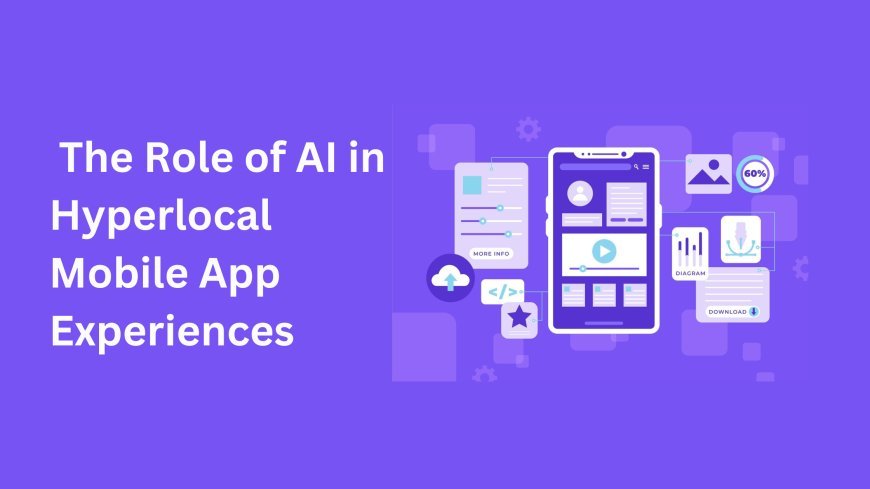The Role of AI in Hyperlocal Mobile App Experiences

Picture this: you open a food delivery app in downtown São Paulo, and instead of the usual list of international chains, you're greeted with local street food vendors, nearby family-owned cafés, and delivery times that sync perfectly with local traffic patterns. No generic interface, no one-size-fits-all experience—just something that feels like it was designed for you, where you are, when you need it. That, in essence, is the power of hyperlocal mobile experiences.
And behind this tailored digital tapestry? Artificial Intelligence.
We're not talking about the AI of sci-fi lore or buzzwords that make headlines once a year. This is the quiet, always-on kind of AI. The one that learns, predicts, and adapts. It’s the algorithmic backbone of some of the most compelling hyperlocal apps we use every day—and it's shaping a future where mobile apps no longer just connect users to services, but to their immediate world.
Let’s dive into how this shift is happening and why businesses—and developers—can’t afford to ignore it.
What Is Hyperlocal, Really?
Before we drop into the tech stack, let’s define the term that gets thrown around far too often.
Hyperlocal refers to content, services, and features that cater to a narrowly defined geographical area—think neighborhoods, districts, or even a few city blocks. It’s not just about geography, though. It’s about relevance.
When mobile apps become hyperlocal, they stop guessing and start knowing—what users need, when they need it, and what’s nearby that can fulfill that need better than anything else.
Hyperlocal isn’t a niche. It’s a necessity. Especially in today’s digital economy where personalization is expected, and generalization is ignored.
Why Hyperlocal Mobile Apps Matter More Than Ever
The rise of "near me" searches isn’t just a trend—it’s a fundamental behavioral shift. People want solutions within arm’s reach, often immediately. This urgency and specificity demand apps that think locally, not globally.
Apps that deliver hyperlocal value drive:
-
Higher engagement – Users are more likely to interact with offers and content that feel contextually relevant.
-
Better retention – When an app gets the local experience right, users don’t look elsewhere.
-
Increased conversions – From bookings to purchases, hyperlocal precision shortens the user journey.
But none of this works without AI. Not at scale.
The Role of AI: From Localization to Personalization
Let’s clear up a common misconception: localization and hyperlocal are not the same. Localization adjusts content linguistically and culturally; hyperlocal adjusts contextually and situationally. AI bridges the gap between the two.
Here’s how:
1. AI-Powered Geo-Intelligence
This is where AI meets maps—but not in the traditional "display a pin" sense.
AI algorithms parse granular location data, cross-reference it with user behavior, environmental conditions (weather, traffic, events), and community trends. The result? Apps that understand place—not just point it out.
Imagine an AI layer that knows a user usually orders takeout only when it rains in their area. Next time the skies darken, the app nudges a personalized meal suggestion—on time, on brand, on location.
2. Natural Language Processing (NLP) with Local Dialects
Voice searches are becoming the norm. But hyperlocal apps need to interpret not just the query, but the way it’s spoken.
AI-driven NLP models now recognize regional dialects, slang, and phrasing. This means a user in Lagos saying “find me suya near me” gets hyper-relevant suggestions, not a confused interface.
AI turns language into local intuition.
3. Behavioral Clustering by Locale
Forget demographics. AI builds user clusters based on shared local behaviors.
Let’s say users in a particular downtown area routinely search for coworking spaces between 8 and 10 AM. A productivity app can proactively highlight desk availability, time-limited discounts, or networking events in those locations—just for those users.
It’s not creepy. It’s just smarter UX.
Hyperlocal Commerce: Where AI Makes Every Transaction Personal
E-commerce apps are evolving into commerce ecosystems. And AI is the invisible hand orchestrating every part of the hyperlocal transaction lifecycle:
-
Product Recommendations – Based on what's trending in that exact neighborhood.
-
Inventory Management – AI helps merchants allocate stock by predicting demand at the street or store level.
-
Delivery Logistics – AI calculates the fastest routes using real-time, hyperlocal traffic and weather data.
Uber Eats, Glovo, and Swiggy are already leveraging these principles. But what’s powerful is that smaller brands now have access to similar AI frameworks—thanks to cloud services and open-source models.
Hyperlocal Content: Curation Without the Noise
One major pain point with content-heavy apps? Relevance. Nobody wants global news when the power is out on their block.
AI filters content streams—news, events, deals—based on hyperlocal signals. It understands what matters here and now. Whether it's parking regulations, farmers’ markets, or spontaneous flash mobs, hyperlocal AI makes the feed feel alive.
Even push notifications evolve from spammy to timely. It’s the difference between “Hey, check out our app!” and “Your favorite yoga class down the street has a last-minute spot open.”
User Journeys That Adapt in Real Time
One of AI's most exciting contributions to hyperlocal apps is journey prediction. These systems don’t just react—they anticipate.
-
A transit app can prompt a bike-share rental as soon as it detects you’ve exited a train.
-
A shopping app might highlight in-store pickup if you’re near a retailer’s physical location.
-
A weather-aware health app can prompt asthma medication reminders when pollen counts spike locally.
Each decision point is driven by real-time data—location, motion, time, behavior. And each one makes the app feel more like a personal assistant than a static tool.
Safety and Trust: AI’s Role in Hyperlocal Verification
When you zoom into neighborhoods and streets, trust becomes critical.
Hyperlocal apps using AI can:
-
Verify local businesses with image recognition and crowd-sourced validation.
-
Combat misinformation by flagging anomalies in user-generated content.
-
Improve safety alerts by triangulating incidents from multiple data sources (e.g., traffic, social, civic).
AI doesn't just enrich experiences—it protects users, too.
Hyperlocal Isn’t Just for Urban Centers
One of the myths about hyperlocal apps? That they only make sense in big cities.
The truth? AI can unlock rural and suburban relevance like never before.
-
Agricultural alerts for local farmers based on hyperlocal weather and soil data.
-
Community-driven commerce where AI connects local makers to buyers within a few miles.
-
Transit alternatives in areas where ride-hailing isn’t scalable, but local drivers and schedules can be optimized.
AI decentralizes digital access. It doesn’t care if it’s Manhattan or a village in Kerala—it just needs data and a use case.
Challenges: The Truth About Getting It Right
Let’s not gloss over the hurdles.
Data Privacy
Hyperlocal means high-resolution data. And that makes privacy a real concern. AI must be paired with:
-
Transparent user permissions
-
Edge computing where data doesn’t leave the device
-
GDPR and CCPA-compliant models
You can’t personalize without trust. Period.
Data Availability
Some regions lack the digital infrastructure to feed AI models. In such cases, smart caching, community input, and adaptive data models are key.
Localization vs. Fragmentation
Over-personalization can make apps feel inconsistent. The trick? Maintain a consistent core UX while letting AI localize the context, not the structure.
What Businesses Need to Know Now
Hyperlocal AI isn’t a luxury feature. It’s a competitive advantage. If you're building a mobile app and ignoring the local layer, you’re shipping a product that’s already a step behind.
Start here:
-
Invest in Location Intelligence APIs – Not just GPS, but context-aware services.
-
Train Models on Local Behavior Data – Anonymized, of course, but rich in signal.
-
Design for Variability – Build modular UX components that AI can arrange dynamically.
-
Make Local a Strategy, Not a Feature – Your app should think like a local, not just look like one.
The Future Is Micro, Not Just Macro
Think of the most successful consumer apps today. What do they have in common?
They feel personal. They feel intelligent. And increasingly, they feel local.
AI is the enabler. Hyperlocal is the outcome.
Together, they redefine what users expect from mobile experiences. Not just convenience—but relevance. Not just content—but context. Not just access—but connection.
And that’s not some far-off promise. It’s happening now, neighborhood by neighborhood, powered by algorithms you probably didn’t even know were running in the background of your favorite app.
Conclusion: It’s Time to Get Hyperlocal—Intelligently
As digital competition grows fiercer, standing out isn’t about flashy features. It’s about understanding users better than anyone else—where they are, how they live, and what they need in the moment.
Hyperlocal mobile apps don’t just help businesses reach users. They help businesses meet users—on their terms, in their world.
And that meeting point? It’s curated, predicted, and personalized by AI.
So if your next app isn’t thinking locally, it may already be losing relevance. Now is the time to hire mobile app developers in Atlanta who understand the interplay of AI, location, and user behavior—and who can bring that understanding to life through tech that feels almost invisible in how seamlessly it works.
Because in the world of mobile apps, global scale is impressive. But hyperlocal precision? That’s transformative.
What's Your Reaction?































































